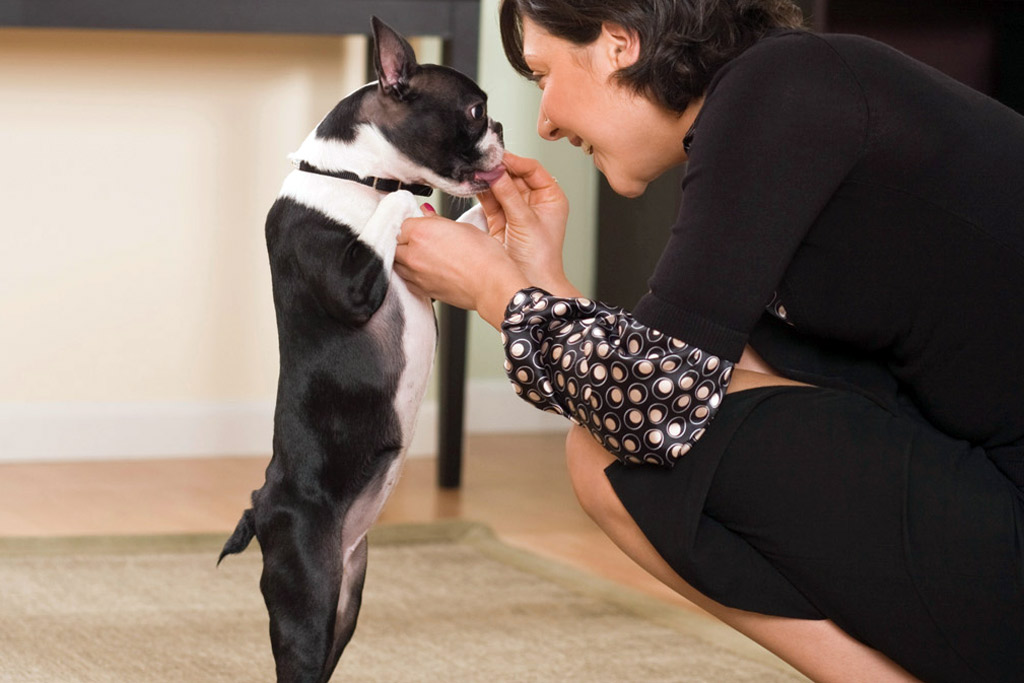
Depending on how familiar you are with the Boston Terrier breed, the facts about their tails (or lack of) can be confusing.
Boston Terriers have tails and are naturally born with a bobtail, which means a short tail or no tail at all. The shape of the tail can also vary from bobbed to curled (screw), crooked, straight or gay.
Although their tails are generally short, they can also have long tails.
There’s more to this, so it’s worth finding out more about Boston Terrier’s tails, types, and what you can expect.
Do Boston Terriers Have Tails?
Boston Terriers, just like the English Bulldog, generally have very short tails at birth, or the tail is completely missing. This feature is a part of the breed characteristics.
On average, most purebred Boston Bull Terriers’ tails do not exceed two inches in length, and the chances of having one with a full-length tail are rare but possible.
However, according to the AKC’s Official Standard of the Boston Terrier, a full-length tail disqualifies this dog from registration. The tail shouldn’t exceed more than a quarter the distance from their back to the top of their hind legs.
The official AKC standard states that to be able to register your Boston Terrier pooch, the preferred tail length should not exceed more than one-quarter the distance from “set-on to hock”.
Insider Tip: “Set-on” is the point where your dog’s tail begins, and the “Hock” point is that sharp angle you see at the back of your dog’s rear legs.

Tail docking is a harmful practice that isn’t (unfortunately) completely banned in some countries, like the U.K. Not only is it a painful procedure for your pooch, especially if not done at birth, but it also causes severe spine problems in the future.
There are no benefits to this practice, it’s an aesthetical choice. Also, tail docking disqualifies a dog from registration.
The tail, or lack of it, has many Boston Terrier owners questioning if their dog is purebred.
Just because a Boston Terrier’s tail is different from the AKC’s breed standards, it doesn’t mean that your pooch isn’t a full-blooded Boston Terrier.
But, since Boston Terriers have been around for 150 years (since the late 1860s) and they have had short tails…
It’s unlikely for any purebred Boston Terrier to genetically turn up with a long tail unless another breed was added to the ancestry line.
Learn more about Boston Terrier’s history at What Were Boston Terriers Originally Bred For? blog post.
The American Kennel Club (AKC) considers Boston Terriers to be a “Bobed Breed”, i.e., they have “bobbed tails” or no tails. This is a cosmetic preference.
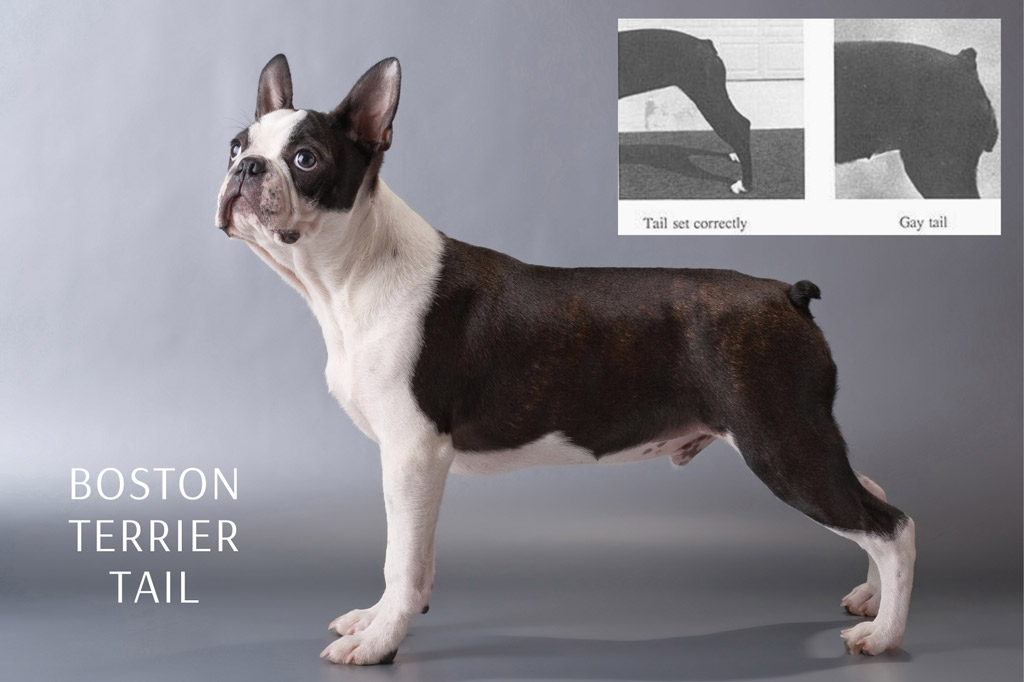
What Types of Tails Do Boston Terriers Have?
Now that we know that it is possible for purebred Boston Terriers to have tails…
Here are the different 5 types of tails that Boston Terriers can have:
#1 – Bobbed Tail
The Boston Terrier is a bobbed breed. They are born with a short tail due to their genes.
This gene mutation causes the tail to grow unusually short, i.e., it’s not because they have been docked (i.e., someone has cut off a portion of the tail).
This is the type of tail that follows AKC’s Official Standard of a Boston Terrier’s tail.
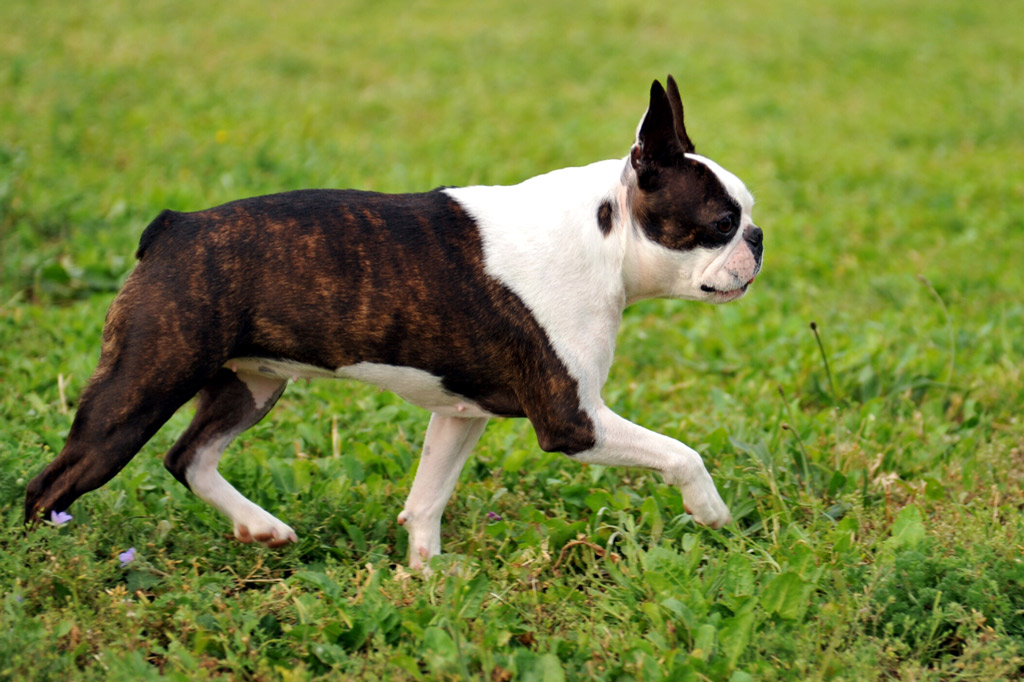
#2 – Curled or Screw Tail
Some Boston Terriers have curled or screw (corkscrew) tails, where the tail is shaped like a button or a bun on the dog’s rear. Generally, it’s about 1 to 2 inches long and is curled up.
Some are curled more tightly than others, making it seem as if the dog has no tail at all.
Note: Such a tight curl requires special attention. Screw tails can be a cause for infection. This occurs when the folds of skin collect dirt and other substances, which over time cause irritation and result in infection.

#3 – Crooked Tail
Boston Terriers can also have crooked tails.
The tail is about 2 to 3 inches long and has a turn about halfway, which causes it to point in the opposite direction.
Note: Crooked tails may cause pain and spinal issues depending on the severity of the crookedness. It is best to speak to your vet to keep an eye on your dog’s development.

#4 – Straight Tail
This is the rarest type of tail for Boston Terriers (since purebreds tails are unusually short or missing). But it’s still a healthy shape.
The tail is set low on the rear, i.e., it points toward the ground when your dog is idle and calm.
Boston Terriers with straight tails will tend to wag their tails more.

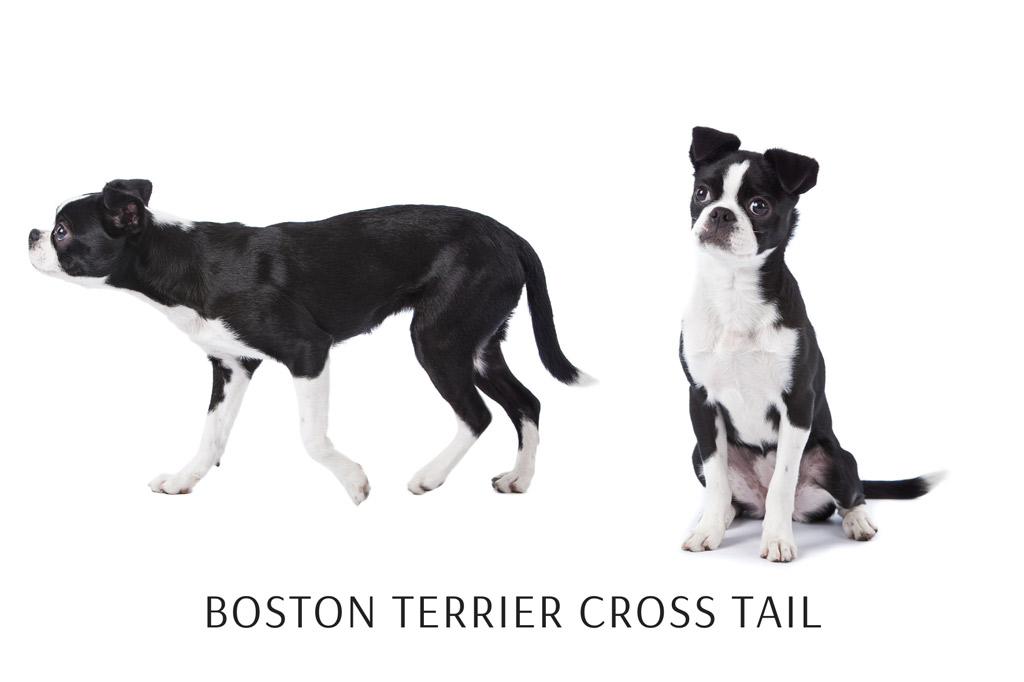
#5 – Gay Tail
The term “gay” refers to the position of the tail.
The gay tail is the same as the bobbed tail, the only difference being the position of the tail – raised up or pointing upwards.
According to the American Kennel Club, a gay tail sits above the horizontal level of the dog’s back.
So, if your Boston Terrier has a gay tail, your dog will carry the tail higher than the breed standards (see photo below).
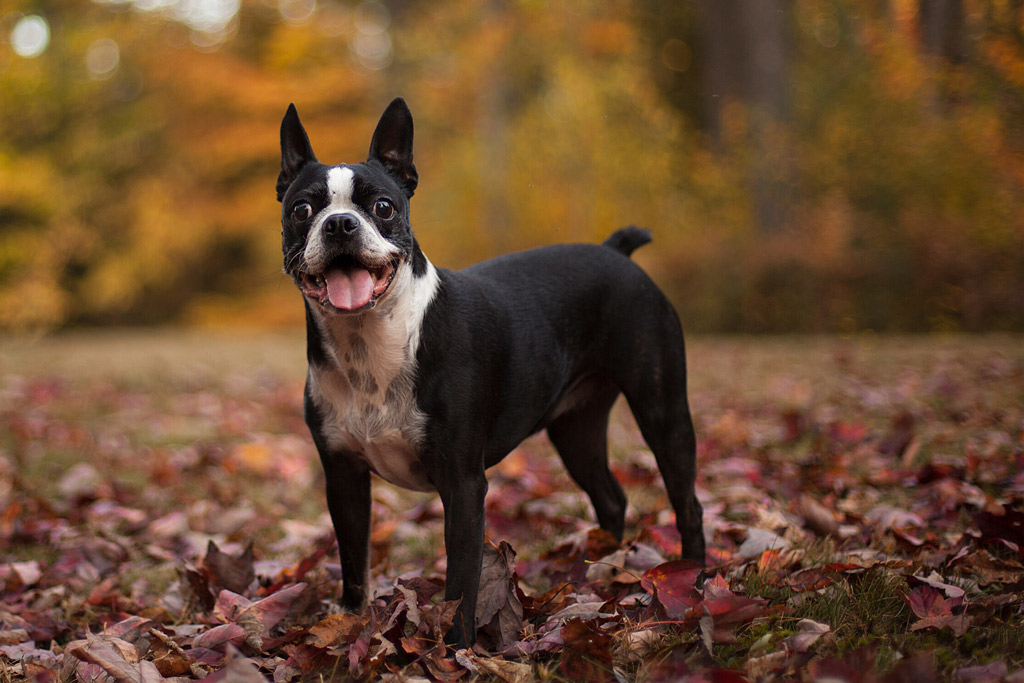
Boston Terriers Tail Problems
The most common health problems with Boston Terriers’ tails are infections and spinal deformities.
Sadly, the only way to prevent tail health problems (like deformities and spinal issues) in Boston Terriers is to simply stop breeding dogs that have malformities.
When breeding dogs that have genetic malformities, we are putting another litter out there with a genetic predisposition to having these same problems. That’s why responsible breeding is so important.
Breeders can prevent future problems with Boston Terrier’s tails and bones by:
- Only mating the standard breed with another standard breed.
- Only mating a standard breed with a straight-tailed breed (whether it’s long or short).
But what if you already have a Boston with tail problems?
Thankfully, there are treatments available. But before that, knowing the symptoms and causes of tail infections and spinal deformities is important:
Tail Infections
When Bostons have a curled or screw tail, they are predisposed to tail infections.
When the skin folds in the tail, it collects dirt and other substances and over time causes irritation. As a result of this, the tail can get infected.
Symptoms of Tail Infection
The usual symptoms of tail infection are:
- Itching and redness in the area.
- Sometimes the tail can have a distinct smell to it due to the pus and dead skin.
Treatment for Tail Infection
Assess the severity and if you are unsure, check with your vet. However, you can start by cleaning the area:
- Wash the area with warm water and antiseptic soap first to remove any dirt.
- Then, you can use an antiseptic spray or wipes.
- After that, use a clean gauze to dry the area.
- You can also apply a soothing cream or coconut oil to help with the healing and reduce skin irritation.
Note: If you feel at any moment that the infection is getting worse, get in touch with your vet.
Insider Tip: As a preventive method, keeping your Boston’s tail clean helps to avoid irritation and infections. You can do this by trimming the hair around the tail regularly and washing it with water if your pooch gets dirty. By doing this, you will keep the tail cleaner and prevent dirt from collecting as much. Coconut oil is also great for skin irritation.

Tail Deformities: Hemivertebrae
Most canine vertebrae are shaped like cylinders, creating a flexible bony tube through which the spinal cord passes.
However, the vertebrae in a Boston Terriers’ tail are shaped like wedges or butterflies. Hemivertebrae refers to the bones in the spine that are abnormally shaped. This condition often leads to the tail being incorrectly aligned.
The screw and crooked tails are often the main cause of this disease due to the bones being twirled and crushing the spinal column and nerves.
As a result, Boston Terriers that have crooked or screw tails can suffer from spinal deformities.
Symptoms of Hemivertebrae
Symptoms include:
- Pain in the tail.
- Wobbliness and loss of hind leg function.
- In extreme cases, they can lose control of their bladder and bowels.
However, some Bostons don’t have symptoms at all and are able to live a long happy life with their abnormally-shaped tail.
Treatment of Hemivertebrae
In not-so-severe cases, treatment will usually consist of anti-inflammatory drugs.
However, more severe cases will require a surgical procedure called Hemilaminectomy in order to relieve the bones pressing on the spinal cord. This surgery can cost between $1500 – $4000.
This is an unexpected expense and is one of many scenarios where dog insurance comes in handy. With Petplan pet insurance, all hereditary and chronic conditions are covered as standard.

Related Questions
Are Some Boston Terriers Born with Tails?
Yes, Boston Terriers are born with tails. Usually, the tail is short, no longer than two inches and it has a bobbed shape. They can also have curled (screw), crooked, or straight tails.
Why Are Some Boston Terriers Born with Tails?
Boston Terriers are born with naturally short tails due to a mutated gene that causes the tail to grow unusually short or no tail at all.
Are Boston Terriers Born with Long Tails?
Although rare, Boston Terriers can have straight and long tails. This is a healthy shape when the tail is set low on the rear.

I hate it when people that are in a position of trust, outright lie to those that they are advising. IE: cropping a tail being harmful and painful. What a load of garbage!! Done at 3 days of age there are NO harm if performed by a qualified breeder or a qualified vet (not all vets are qualified, obviously).
STOP pushing your own agenda. How much better to dock a tail on a working dog at 3 days while the tail is still cartilage and there are no nerve endings to the tail then to have it break it’s tail later on and actually have to AMPUTATE the tail which is now solid bone and a limb. WHAT do you suppose is more painful and harmful to the dog??
There’s no agenda here, Lena. I did say:
The practice is illegal in England, Wales, Scotland and Northern Ireland, although there are however some exemptions, such as removal of the tail by a vet for medical reasons or for certain breeds of working dogs. I’m aware that another reason is to prevent possible injury, but we’re at a very different and high level of concern if at that stage i.e. would we typically have to worry about our pet dogs getting injured to a point where amputation would be necessary?